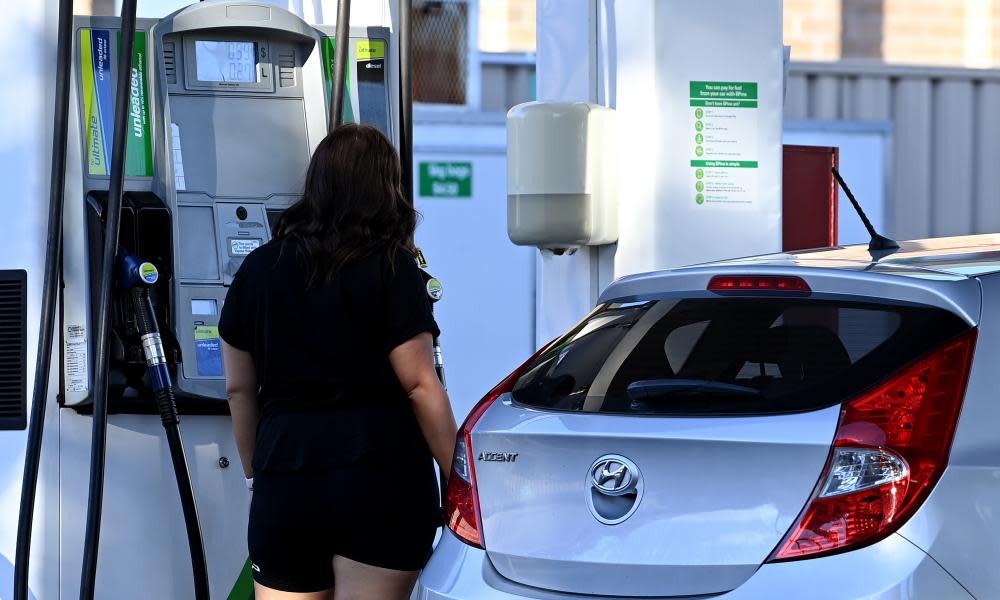Australian drivers facing fuel price hike of up to 24 cents a litre as excise cut expires

Australian motorists are already being slugged by “unacceptably high” fuel prices ahead of the end of the fuel excise cut that will lift bowser costs by as much as 24 cents a litre, the NRMA has said.
The Albanese government has resisted pressure to extend the six-month halving of the fuel excise, which will expire at midnight on Wednesday. The policy, inherited from the Morrison government, cost the budget $3bn.
The Australian Competition and Consumer Commission has warned service stations that it will be watching for outlets that pass on the increase to customers before running down supplies of fuel that was not fully taxed.
Related: Reinstating the fuel excise: how much will petrol prices rise and why now?
Peter Khoury, a senior spokesperson for motorist group NRMA, said recent increases at the bowser showed that companies have been hiking prices well above what was justified by global market conditions.
“The prices in Sydney, Brisbane, Melbourne and Adelaide today are already way too high,” Khoury said.
Average prices are “anywhere between 10 and 12 cents a litre higher than they should be”, he said. “The oil companies have already been put on notice.”
Data provided by the Australian Institute of Petroleum showed the margin between wholesale and retail prices has recently blown out to about 40 cents. Khoury said that was the widest since before the Covid pandemic.
At a media conference to accompany the release of the better-than-expected final budget figures for the 2021-22 fiscal year, the federal treasurer, Jim Chalmers, said the government understood “the pressures that Australians are under all around Australia”.
“We will provide responsible cost-of-living relief in areas like childcare and medicines and Tafe fees and we will get wages moving again,” Chalmers said. “But we can’t afford to fund every bit of cost of living relief indefinitely that people would like us to – that’s just the reality of the situation.”
The deficit for the year just ended came in at $32bn, or 1.4% of Australia’s gross domestic product. At the time of the March budget, which introduced the fuel excise, the projected deficit had been $79.8bn, or 3.5%.
Related: Conflict in South China Sea would threaten 90% of Australia’s fuel imports
Khoury said city service stations took up to seven days to pass on savings from the cut in the excise back in late March and April. Service stations in regional areas took twice as long.
If they are being consistent, he said, it should take service stations just as long to pass on the increase. He said he was confident that outlets would be caught by the ACCC if they unfairly raised prices on partially excised fuel.
Australian average fuel prices peaked at about $2.20 a litre not long after global oil prices peaked. International prices have since plunged about $US60 ($A94) a barrel but local motorists are yet to enjoy the full benefits of the drop.
Related: Australian motorists may be unwittingly bankrolling Russia’s invasion of Ukraine, report finds
“Despite falling global prices, and the full fuel excise tax not yet reinstated, prices in Sydney are approaching $2 per litre,” Khoury said.
Khoury said it always paid to check websites that covered live fuel prices.
The website run by Victoria’s RACV, for instance, showed prices were varying between about $1.60 to $1.98 a litre, as of Wednesday afternoon.
The affect of higher fuel prices on inflation is likely to be modest, in part because petrol and diesel prices had already been climbing a year ago, lifting the comparative baseline.
In the December quarter of 2021 transport costs were already the biggest contributor among goods to the higher inflation.
Automotive fuel was 32.3% higher in the quarter from a year earlier compared with a 3.5% overall CPI increase, the ABS said.

 Yahoo Movies
Yahoo Movies 
